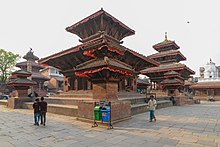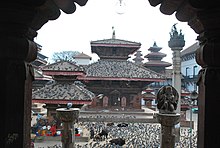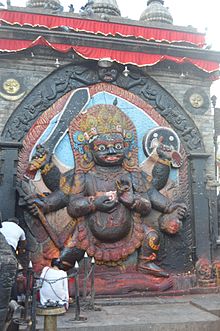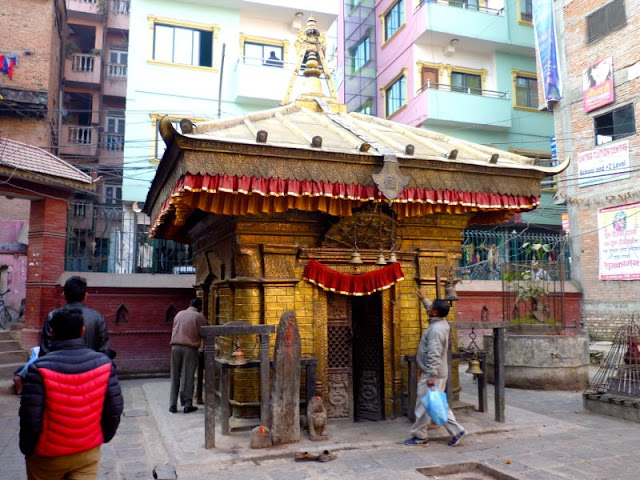Kathmandu Durbar Square
Kathmandu Durbar Square (Basantapur Darbar Kshetra) in front of the old royal palace of the former Kathmandu Kingdom is one of three Durbar (royal palace) Squares in the Kathmandu Valley in Nepal, all of which are UNESCO World Heritage Sites.
Several buildings in the Square collapsed due to a major earthquake on 25 April 2015. Durbar Square was surrounded with spectacular architecture and vividly showcases the skills of the Newar artists and craftsmen over several centuries. The Royal Palace was originally at Dattaraya square and was later moved to the Durbar square.[1]
The Kathmandu Durbar Square held the palaces of the Malla and Shah kings who ruled over the city. Along with these palaces, the square surrounds quadrangles, revealing courtyards and temples. It is known as Hanuman Dhoka Durbar Square, a name derived from a statue of Hanuman, the monkey devotee of Lord Ram, at the entrance of the palace.
History and construction[edit]
The preference for the construction of royal palaces at this site dates back to as early as the Licchavi period in the third century. Even though the present palaces and temples have undergone repeated and extensive renovations and nothing physical remains from that period. Names like Gunapo and Gupo, which are the names referred to the palaces in the square in early scriptures, imply that the palaces were built by Gunakamadev, a King ruling late in the tenth-century. When Kathmandu City became independent under the rule of King Ratna Malla (1484–1520), the palaces in the square became the Royal Palaces for its Malla Kings. When Prithvi Narayan Shah invaded the Kathmandu Valley in 1769, he favored the Kathmandu Durbar Square for his palace. Other subsequent Shah kings continued to rule from the square until 1896 when they moved to the Narayan Hiti Palace.
The square is still the center of important royal events like the coronation of King Birendra Bir Bikram Shah in 1975 and King Gyanendra Bir Bikram Shah in 2001.
Though there are no written archives stating the history of Kathmandu Durbar Square, construction of the palace in the square is credited to Sankharadev (1069–1083). As the first king of the independent Kathmandu City, Ratna Malla is said to have built the Taleju temple in the Northern side of the palace in 1501. For this to be true then the temple would have had to have been built in the vihara style as part of the palace premise surrounding the Mul Chok courtyard for no evidence of a separate structure that would match this temple can be found within the square.
Construction of the Karnel Chok is not clearly stated in any historical inscriptions; although, it is probably the oldest among all the courtyards in the square. The Bhagavati Temple, originally known as a Narayan Temple, rises above the mansions surrounding it and was added during the time of Jagajaya Malla in the early eighteenth century. The Narayan idol within the temple was stolen so Prithvi Narayan Shah replaced it with an image of Bhagavati, completely transforming the name of the temple.
The oldest temples in the square are those built by Mahendra Malla (1560–1574). They are the temples of Jagannath, Kotilingeswara Mahadev, Mahendreswara, and the Taleju Temple. This three-roofed Taleju Temple was established in 1564, in a typical Newari architectural style and is elevated on platforms that form a pyramid-like structure. It is said that Mahendra Malla, when he was residing in Bhaktapur, was highly devoted to the Taleju Temple there; the Goddess being pleased with his devotion gave him a vision asking him to build a temple for her in the Kathmandu Durbar Square. With a help of a hermit, he designed the temple to give it its present form and the Goddess entered the temple in the form of a bee.
His successors Sadasiva (1575–1581), his son, Shiva Simha (1578–1619), and his grandson, Laksmi Narsingha (1619–1641), do not seem to have made any major additions to the square. During this period of three generations the only constructions to have occurred were the establishment of Degutale Temple dedicated to Goddess Mother Taleju by Shiva Simha and some enhancement in the royal palace by Laksminar Simha.
Under Pratap Malla[edit]
In the time of Pratap Malla, son of Laksminar Simha, the square was extensively developed. He was an intellectual, a pious devotee, and especially interested in arts. He called himself a Kavindra, king of poets, and boasted that he was learned in fifteen different languages. A passionate builder, following his coronation as a king, he immediately began enlargements to his royal palace, and rebuilt some old temples and constructed new temples, shrines and stupas around his kingdom.
During the construction of his palace, he added a small entrance in the traditional, low and narrow Newari style. The door was elaborately decorated with carvings and paintings of deities and auspicious sings and was later transferred to the entrance of Mohan Chok. In front of the entrance he placed the statue of Hanuman thinking that Hanuman would strengthen his army and protect his home. The entrance leads to Nasal Chok, the courtyard where most royal events such as coronation, performances, and yagyas, holy fire rituals, take place. It was named after Nasadya, the God of Dance, and during the time of Pratap Malla the sacred mask dance dramas performed in Nasal Chok were widely famed. In one of these dramas, it is said that Pratap Malla himself played the role of Lord Vishnu and that the spirit of the Lord remained in the king's body even after the play. After consulting his Tantric leaders, he ordered a stone image of Lord Vishnu in his incarnation as Nara Simha, the half-lion and half-human form, and then transferred the spirit into the stone. This fine image of Narasimha made in 1673 still stands in the Nasal Chok. In 1650, he commissioned for the construction of Mohan Chok in the palace. This chok remained the royal residential courtyard for many years and is believed to store a great amount of treasure under its surface. Pratap Malla also built Sundari Chok about this time. He placed a slab engraved with lines in fifteen languages and proclaimed that he who can understand the inscription would produce the flow of milk instead of water from Tutedhara, a fountain set in the outer walls of Mohan Chok. However elaborate his constructions may have been, they were not simply intended to emphasize his luxuries but also his and the importance of others' devotion towards deities. He made extensive donations to temples and had the older ones renovated. Next to the palace, he built a Krishna temple, the Vamsagopala, in an octagonal shape in 1649. He dedicated this temple to his two Indian wives, Rupamati and Rajamati, as both had died during the year it was built. In Mohan Chok, he erected a three roofed Agamachem temple and a unique temple with five superimposing roofs. After completely restoring the Mul Chok, he donated to the adjoining Taleju Temple. To the main temple of Taleju, he donated metal doors in 1670. He rebuilt the Degutale Temple built by his grandfather, Siva Simha, and the Taleju Temple in the palace square. As a substitute to the Indreswara Mahadeva Temple in the distant village of Panauti he built a Shiva temple, Indrapura, near his palace in the square. He carved hymns on the walls of the Jagannath Temple as prayers to Taleju in the form of Kali.
At the southern end of the square, near Kasthamandap at Maru, which was the main city crossroads for early traders, he built another pavilion named Kavindrapura, the mansion of the king of poets. In this mansion he set an idol of dancing Shiva, Nasadyo, which today is highly worshipped by dancers in the Valley.
In the process of beautifying his palace, he added fountains, ponds, and baths. In Sundari Chok, he established a low bath with a golden fountain. He built a small pond, the Naga Pokhari, in the palace adorned with Nagakastha, a wooden serpent, which is said he had ordered stolen from the royal pond in the Bhaktapur Durbar Square. He restored the Licchavi stone sculptures such as the Jalasayana Narayana, the Kaliyadamana, and the Kala Bhairav. An idol of Jalasayana Narayana was placed in a newly created pond in the Bhandarkhal garden in the eastern wing of the palace. As a substitute to the idol of Jalasayana Narayana in Buddhanilkantha, he channeled water from Buddhanilkantha to the pond in Bhandarkhal due bestow authenticity. The Kalyadana, a manifestation of Lord Krishna destroying Kaliya, a water serpent, is placed in Kalindi Chok, which is adjacent to the Mohan Chok. The approximately ten-feet-high image of terrifyingly portrayed Kal Bhairav is placed near the Jagannath Temple. This image is the focus of worship in the chok especially during Durga Puja.
With the death of Pratap Malla in 1674, the overall emphasis on the importance of the square came to a halt. His successors retained relatively insignificant power and the prevailing ministers took control of most of the royal rule. The ministers encountered little influence under these kings and, increasingly, interest of the arts and additions to the square was lost on them. They focused less on culture than Pratap Malla during the three decades that followed his death, steering the city and country more towards the arenas of politics and power, with only a few minor constructions made in the square. These projects included Parthivendra Malla building a temple referred to as Trailokya Mohan or Dasavatara, dedicated to Lord Vishnu in 1679. A large statue of Garuda, the mount of Lord Vishnu, was added in front of it a decade later. Parthivendra Malla added a pillar with image of his family in front of the Taleju Temple.
Around 1692, Radhilasmi, the widowed queen of Pratap Malla, erected the tall temples of Shiva known as Maju Deval near the Garuda image in the square. This temple stands on nine stepped platforms and is one of the tallest buildings in the square. Then her son, Bhupalendra Malla, took the throne and banished the widowed queen to the hills. His death came early at the age of twenty one and his widowed queen, Bhuvanalaksmi, built a temple in the square known as Kageswara Mahadev. The temple was built in the Newari style and acted as a substitute for worship of a distant temple in the hills. After the earthquake in 1934, the temple was restored with a dome roof, which was alien to the Newari architecture.
Jayaprakash Malla, the last Malla king to rule Kathmandu, built a temple for Kumari and Durga in her virginal state. The temple was named Kumari Bahal and was structured like a typical Newari vihara. In his house resides the Kumari, a girl who is revered as the living goddess. He also made a chariot for Kumari and in the courtyard had detailed terra cotta tiles of that time laid down.











Comments
Post a Comment